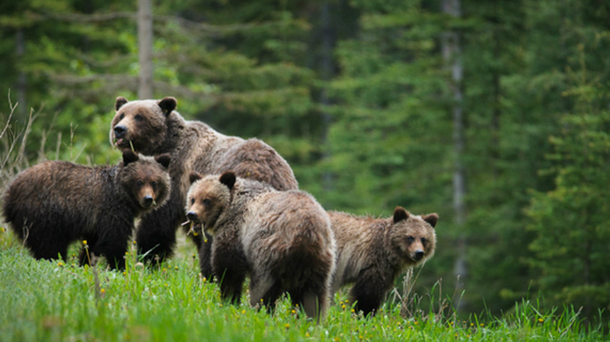Trophy Hunting in the Great Bear Rainforest
Archive ∙ Back to Island Voices
April 2014

Trophy Hunting in the Great Bear Rainforest
Here in BC we are blessed to be home to the world’s largest pristine coastal temperate forest, the Great Bear Rainforest. Every year thousands of tourists flock here from around the world to observe the iconic grizzly bear in its natural habitat. These wildlife enthusiasts are fortunate enough to witness the gathering of dozens of these awe-inspiring creatures, as parents and their young emerge from hibernation and set out on their search for food. Continue
Unfortunately, at this same time, a considerably smaller group of predominantly American tourists come to this same forest to engage in trophy killing. This “sport”, in which the hunters shoot a bear, cut off its head, and then leave the body to rot, claims the lives of hundreds of grizzlies each year; sometimes leaving behind newly orphaned cubs with no means of survival.
Trophy killing has been banned by nine coastal First Nations and, according to a province-wide study conducted by the Coastal First Nation Great Bear initiative, is opposed by nearly 90% of British Columbians and 95% of hunters.
Despite these statistics, in November of last year the provincial government announced plans to expand areas open to trophy killing. The proposed expansion includes the Cariboo and the Kootenay region, the latter of which borders the American states of Washington, Idaho and Montana, where Grizzlies have been listed as “threatened” under the American Endangered Species Act. Both areas have hosted grizzly bear hunts in the past but had since been closed as a result of overhunting. Likewise, grizzly bear hunting has been suspended in the lower 48 states of the US, as well as in our eastern neighbor Alberta.
Once roaming much of western North America and the Great Plains, grizzly populations were gradually eliminated from most of these areas due to European settlement. In fact, it is estimated that only about 1,000 grizzly bears remain in the United States today. Although population numbers are currently more promising in Canada, we may be setting ourselves up for a similar fate. While British Columbia officials estimate that there are roughly 15,000 grizzly bears in the province, other experts have claimed that the numbers could be as low as 8,000. The cause of these discrepancies in numbers can likely be attributed to the often sparse and outdated methods from which the data is gathered. The truth of the matter is we have no idea how many grizzly bears there actually are in the Great Bear Rainforest, let alone elsewhere in BC. Combine this uncertainty in current population size with the uncertainty climate change impacts will have on the bear’s livelihood, and we have a population that might be in a more dire situation than any of us know.
However, there are a few things we do know. In the Great Bear Rainforest alone, at least 60 times more tourists engaged in bear viewing than in trophy killing activities. With bear viewers coming from a wide mix of international countries, compared to the predominantly American trophy hunters. Similarly, grizzly bear viewing generated 12 times more in visitor spending than grizzly bear killing (approximately $15.1 million vs $1.2 million) and over 11 times more in direct revenue for BC’s provincial government. Likewise, bear viewing generated 50 times more jobs than trophy killing (approximately 510 jobs/year vs 11 jobs/year in 2012). This study conducted by the Centre for Responsible Tourism and funded by Tides Canada, concluded that bear watching ecotourism is far more profitable than trophy hunting. In light of all of this evidence, I have urged the provincial government to support an immediate moratorium on the trophy killing of Grizzly Bears in the Great Bear Rainforest. We would never condone the trophy killing of an orca, another iconic BC species, so how can we condone the trophy killing of the grizzly bear?
To read my speech from the “Save BC Bears” rally at the BC Legislature in February, please click here. Also, to read the questions I posed to the Minister of Forests, Lands, and Natural Resource Operations on the issue, please click here.
Best Wishes,
Andrew


